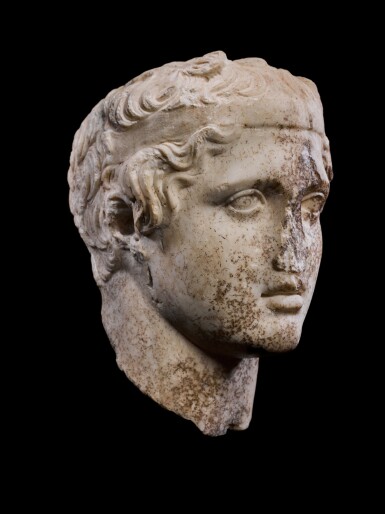Master Sculpture from Four Millennia
Master Sculpture from Four Millennia

Property of a European Private Collector
A Roman Marble Head of Dionysos, circa 1st Century A.D.
Auction Closed
July 3, 02:32 PM GMT
Estimate
200,000 - 300,000 GBP
Lot Details
Description
A Roman Marble Head of Dionysos
circa 1st Century A.D.
over-lifesize, after a Greek classical sculpture of the 5th century B.C., with full parted lips, his hair radiating from the crown in crescentic locks, bound in a broad fillet passing over the forehead, and waving back at the temples leaving the ears bare.
Height 34 cm.
Rome art market
Munich art market, by 1932
private collection, Switzerland, acquired in the early 1980s
by descent from the above to the present owner
Documented
three photographs accessioned in 1932 in the Deutsches Archäologisches Institut Rom: D-DAI-ROM-2631_A12-A14: arachne.dainst.org/entity/775167, arachne.dainst.org/entity/775168, arachne.dainst.org/entity/775169
three photographs accessioned in 1933 in the Deutsches Archäologisches Institut Rom: D-DAI-ROM-33.809-11: arachne.dainst.org/entity/4673109; arachne.dainst.org/entity/4673111; arachne.dainst.org/entity/4673112 ("Rom, Kunsthandel")
Published
Paul Arndt and Georg Lippold, Brunn-Bruckmanns Denkmäler griechischer und römischer Sculptur, Munich, 1932, no. 745, figs. 1-3
Erwin Pochmarski, Das Bild des Dionysos in der Rundplastik der klassischen Zeit Griechenlands, Vienna, 1974, pp. 144ff., fig. 34a
Carlo Gasparri, "Dionysos," in: Lexicon Iconographicum Mythologiae Classicae, vol. 3, Zürich, 1986, p. 444, no. 198b, pl. 319
Exhibited
on loan to the Antikenmuseum Basel, 1981-2024 (on view in the 1980s and 90s)
The present head, of vivid and careful workmanship, is a prime example of the sculptural style of the Parthenon pediments. The few still discernible strands of hair on the badly weathered head of the reclining figure of Dionysos from the Parthenon's east pediment show a related disposition and rendering of the locks. It is tempting to imagine that the head of the Parthenon figure resembled the present head in other ways. By contrast, the present head wears a broad fillet covered by the hair in back, whereas the head of the Parthenon figure wears a plaited fillet covered by the hair in front. Another avenue of comparison leads to the head of the Doryphoros of Polykleitos (see the bronze replica from Herculaneum: arachne.dainst.org/entity/1073522), which has a similar, yet higher placed starfish-like hair motif on the crown of the head.
You May Also Like









